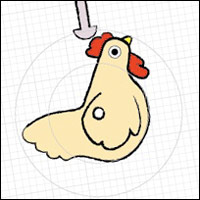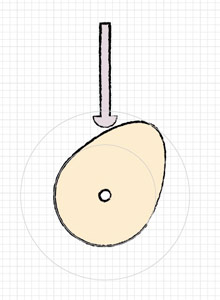 Cams are a simple mechanism that can be used to create quite complex movements. As the cam turns a cam follower, which is touching the surface of the cam, moves up and down in a movement described by the profile of the cam.
Cams are a simple mechanism that can be used to create quite complex movements. As the cam turns a cam follower, which is touching the surface of the cam, moves up and down in a movement described by the profile of the cam.
In a simple cam such as the egg shaped cam shown here, the cam follower is stationary for most of the turn before rising and falling smoothly but quickly in the last portion of the turn. This type of cam can run both clockwise and anti-clockwise.
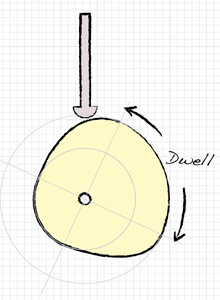 By changing the shape of the cam profile the automata designer can change how a model moves. In this case a quarter circle area is at the maximum diameter of the cam. As this part of the cam moves past the cam follower, the cam follower remains stationary. The size of these large flat areas is known as the dwell angle. In the case the dwell angle is 90º
By changing the shape of the cam profile the automata designer can change how a model moves. In this case a quarter circle area is at the maximum diameter of the cam. As this part of the cam moves past the cam follower, the cam follower remains stationary. The size of these large flat areas is known as the dwell angle. In the case the dwell angle is 90º
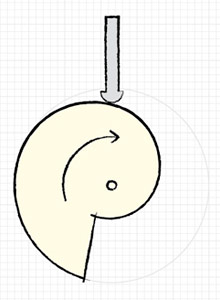 The snail cam, shown here, is a commonly used cam profile. The snail cam profile is a simple spiral. As the cam turns, the cam followers rises at a steady rate until it reaches the step where it drops suddenly. The snail cam is at the heart of the Early Bird model.
The snail cam, shown here, is a commonly used cam profile. The snail cam profile is a simple spiral. As the cam turns, the cam followers rises at a steady rate until it reaches the step where it drops suddenly. The snail cam is at the heart of the Early Bird model.
Snail cams cam only turn one direction, in this case clockwise. If they are reversed the cam follower jams up against the step.
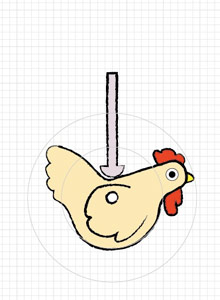 Cam profiles can be any shape. Complex profiles can be used to describe complicated movements. In the model, Which Came First, the usual egg shaped cam driving a pecking chicken are swapped over so that a chicken shaped cam drives a rocking egg. Which came first indeed!
Cam profiles can be any shape. Complex profiles can be used to describe complicated movements. In the model, Which Came First, the usual egg shaped cam driving a pecking chicken are swapped over so that a chicken shaped cam drives a rocking egg. Which came first indeed!
Two different cam profiles showing the effect of different dwell angles.
A snail cam and an irregular cam in action
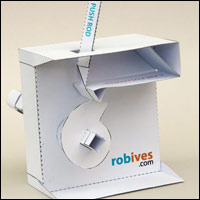 Find out more about cams by making your own cam model. Download and make the interchangeable cam kit; use it try out the movement created with the different cam profiles included in the kit. You can also experiment with your own profiles using the blank cams provided. Members can download the kit for free.
Find out more about cams by making your own cam model. Download and make the interchangeable cam kit; use it try out the movement created with the different cam profiles included in the kit. You can also experiment with your own profiles using the blank cams provided. Members can download the kit for free.
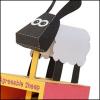 Download and make the Agreeable Sheep for free and find out how cams work first hand!
Download and make the Agreeable Sheep for free and find out how cams work first hand!

